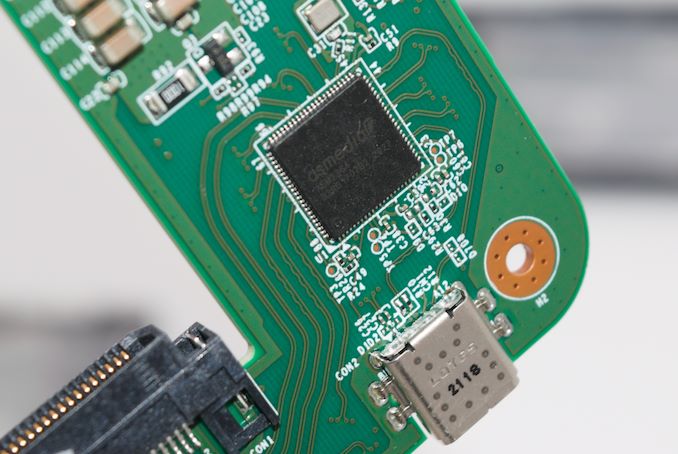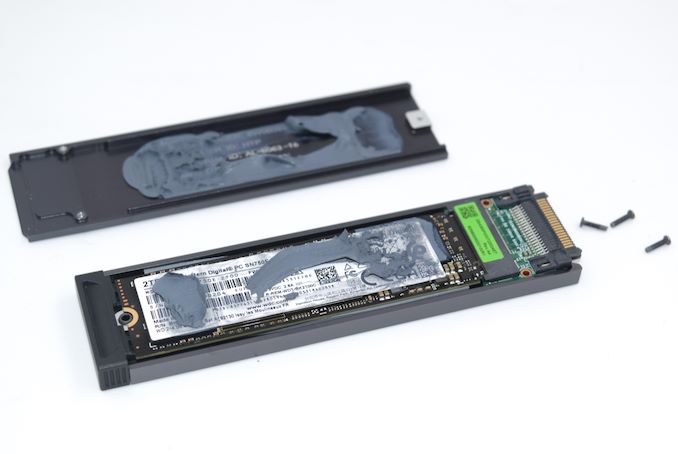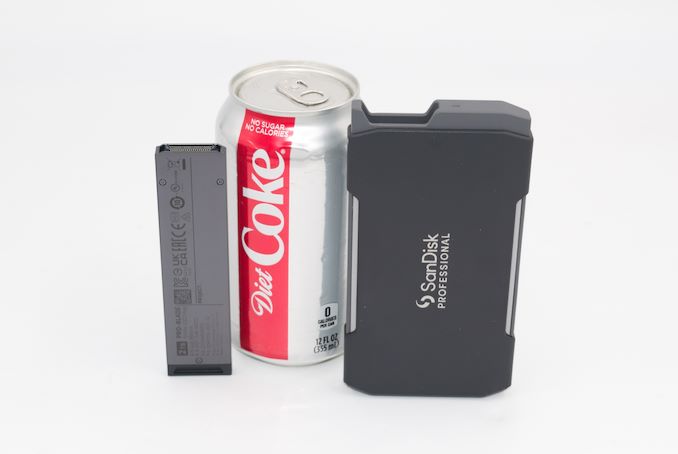
Original Link: https://www.anandtech.com/show/21286/sandisk-professional-problade-portable-ssd-ecosystem-review
SanDisk Professional PRO-BLADE Portable SSD Ecosystem Review
by Ganesh T S on March 7, 2024 8:00 AM EST
Western Digital had unveiled the SanDisk Professional PRO-BLADE modular SSD ecosystem in mid-2022 to serve the needs of the professional market. The PRO-BLADE family comprises of three product lines - compact and sturdy NVMe drives (PRO-BLADE SSD Mags), a USB 3.2 Gen 2x2 (20 Gbps) enclosure for the mags (PRO-BLADE TRANSPORT), and a four-bay Thunderbolt enclosure (PRO-BLADE STATION) directly compatible with the mags. The mags are essentially M.2 2280 NVMe SSDs with a custom connector that directly exposes the internal PCIe Gen3 x4 interface, albeit with support for a higher number of mating cycles compared to the native M.2 2280 internal SSD one.
The PRO-BLADE ecosystem targets professionals in the content capture industry involved in multi-user / multi-site workflows. The typical use-case involves the SSD Mags in TRANSPORT enclosures on-site. Different team members can have their own TRANSPORT enclosures across which the SSD Mags may be hot-swapped. The central location with the PRO-BLADE STATION has the ability to ingest data from multiple SSD mags at speeds (Thunderbolt 3) higher than what is possible with the 20 Gbps TRANSPORT enclosures.
Western Digital sampled multiple PRO-BLADE SSD Mags and TRANSPORT enclosures for evaluation. This review takes a detailed look at the internals of the PRO-BLADE SSD Mag and the PRO-BLADE TRANSPORT enclosure, followed by a discussion of the results of putting the 2TB and 4TB combinations through our rigorous direct-attached storage performance evaluation routine. Prior to discussing the value proposition, we also look at the power consumption and thermal profile of the two configurations.
Introduction and Product Impressions
Portable storage drives have evolved rapidly over the last decade. There are multiple high-performance options in different form-factors for consumer and prosumer use-cases. The requirements for professionals involved in the content capture industry had typically been fulfilled using bulky storage arrays based on HDDs. Advancements in flash technology have disrupted this segment also.
Vendors designing bus-powered flash-based direct-attached storage devices need to keep performance consistency, power consumption, and pricing in mind. The ideal device would have high performance consistency (across extended stress periods, as well as workload types), low power consumption, and low cost. In practice, there are trade-offs involved, and the optimization of different aspects are done depending on the target market segment. The content-capture industry is sensitive to performance consistency. Pricing is not usually a major concern, and power inefficiency is usually tolerated as long as the performance is good.
Western Digital offers the PRO-BLADE SSD Mags for standalone purchase in 1TB, 2TB, and 4TB capacities. Users need either the PRO-BLADE TRANSPORT enclosure or PRO-BLADE STATION to enable a host system to use the storage capacity. Users can also purchase one of the four available PRO-BLADE TRANSPORT configurations (the 0TB empty enclosure, or the 1TB or 2TB or 4TB versions which come with a single PRO-BLADE SSD Mag of the appropriate capacity).
The PRO-BLADE SSD Mags have a gumstick form-factor. They are essentially a thermal cladding for a M.2 2280 NVMe SSD with a customized PCIe Gen3 x4 connector. This connector allows for a sung fit inside the TRANSPORT enclosure's receptacle. The TRANSPORT 2TB package pictured below includes a 50cm. USB 3.2 Gen 2x2 20 Gbps Type-C to Type-C cable along with a warranty guide and an user guide.
Both the SSD Mag and the TRANSPORT enclosure are held together by Torx screws that are simple to take apart. The gallery below presents a closer look at the enclosure and mag design, as well as their internals.
The screws inside the enclosure after taking apart the cladding are normal ones. Both segments of the TRANSPORT enclosure are solid metal with good thermal conduction paths (involving a thermal pad and a raised metal block on the case for the bridge chip).
The enclosure has a stylish and solid feel to it with the ridges on the side giving users additional traction. The recessed nature of the holding end of the SSD mag is also designed keeping the user experience with swapping mags across different enclosures and the PRO-BLADE STATION in mind.
Western Digital utilizes an ASMedia ASM2364 bridge chip under the thermal pad in the TRANSPORT enclosure's board.
The SSD mag incorporates the Western Digital WD_BLACK SN750E M.2 2280 Gen3 x4 NVMe SSD with plenty of thermal paste ensuring good contact with the metal sides. This SSD utilizes an in-house SanDisk controller along with 3D TLC NAND (BiCS 4 96L 3D TLC) and DRAM for the flash translation layer.
The combination of the WD_BLACK SN750E and the ASMedia ASM2364 has already been seen in the WD_BLACK P50 USB 3.2 Gen 2x2 PSSD. This combination supports S.M.A.R.T passthrough along with TRIM, as shown in the CrystalDiskInfo screenshot below.
| Comparative Direct-Attached Storage Devices Configuration | ||
| Aspect | ||
| Downstream Port | PCIe 3.0 x4 | PCIe 3.0 x4 |
| Upstream Port | PCIe 3.0 x4 (SSD Mag) USB 3.2 Gen 2x2 Type-C (TRANSPORT) |
PCIe 3.0 x4 (SSD Mag) USB 3.2 Gen 2x2 Type-C (TRANSPORT) |
| Bridge Chip | ASMedia ASM2364 (TRANSPORT) | ASMedia ASM2364 (TRANSPORT) |
| Power | Bus Powered | Bus Powered |
| Use Case | Compact portable SSD with separate TRANSPORT enclosure targeting multi-user / multi-location professional use-cases | Compact portable SSD with separate TRANSPORT enclosure targeting multi-user / multi-location professional use-cases |
| Physical Dimensions | 109.8 mm x 28 mm x 7.5 mm (SSD Mag) 130.4 mm x 71.5 mm x 16 mm (TRANSPORT) |
109.8 mm x 28 mm x 7.5 mm (SSD Mag) 130.4 mm x 71.5 mm x 16 mm (TRANSPORT) |
| Weight | 45 grams (SSD Mag) 165 grams (TRANSPORT) |
45 grams (SSD Mag) 165 grams (TRANSPORT) |
| Cable | 50 cm USB 3.2 Gen 2x2 20Gbps Type-C to Type-C | 50 cm USB 3.2 Gen 2x2 20Gbps Type-C to Type-C |
| S.M.A.R.T Passthrough | Yes | Yes |
| UASP Support | Yes | Yes |
| TRIM Passthrough | Yes | Yes |
| Hardware Encryption | No | No |
| Evaluated Storage | WD_BLACK SN750E (SanDisk 96L BiCS4 3D TLC) | WD_BLACK SN750E (SanDisk 96L BiCS4 3D TLC) |
| Price | USD 340 | USD 220 |
| Review Link | SanDisk Professional PRO-BLADE TRANSPORT 4TB Review | SanDisk Professional PRO-BLADE TRANSPORT 2TB Review |
Prior to looking at the benchmark numbers, power consumption, and thermal solution effectiveness, a description of the testbed setup and evaluation methodology is provided.
Testbed Setup and Evaluation Methodology
Direct-attached storage devices (including thumb drives) are evaluated using the Quartz Canyon NUC (essentially, the Xeon / ECC version of the Ghost Canyon NUC) configured with 2x 16GB DDR4-2667 ECC SODIMMs and a PCIe 3.0 x4 NVMe SSD - the IM2P33E8 1TB from ADATA.
The most attractive aspect of the Quartz Canyon NUC is the presence of two PCIe slots (electrically, x16 and x4) for add-in cards. In the absence of a discrete GPU - for which there is no need in a DAS testbed - both slots are available. In fact, we also added a spare SanDisk Extreme PRO M.2 NVMe SSD to the CPU direct-attached M.2 22110 slot in the baseboard in order to avoid DMI bottlenecks when evaluating Thunderbolt 3 devices. This still allows for two add-in cards operating at x8 (x16 electrical) and x4 (x4 electrical). Since the Quartz Canyon NUC doesn't have a native USB 3.2 Gen 2x2 port, Silverstone's SST-ECU06 add-in card was installed in the x4 slot. All non-Thunderbolt devices are tested using the Type-C port enabled by the SST-ECU06.
The specifications of the testbed are summarized in the table below:
| The 2021 AnandTech DAS Testbed Configuration | |
| System | Intel Quartz Canyon NUC9vXQNX |
| CPU | Intel Xeon E-2286M |
| Memory | ADATA Industrial AD4B3200716G22 32 GB (2x 16GB) DDR4-3200 ECC @ 22-22-22-52 |
| OS Drive | ADATA Industrial IM2P33E8 NVMe 1TB |
| Secondary Drive | SanDisk Extreme PRO M.2 NVMe 3D SSD 1TB |
| Add-on Card | SilverStone Tek SST-ECU06 USB 3.2 Gen 2x2 Type-C Host |
| OS | Windows 10 Enterprise x64 (21H1) |
| Thanks to ADATA, Intel, and SilverStone Tek for the build components | |
The testbed hardware is only one segment of the evaluation. Over the last few years, the typical direct-attached storage workloads for memory cards have also evolved. High bit-rate 4K videos at 60fps have become quite common, and 8K videos are starting to make an appearance. Game install sizes have also grown steadily even in portable game consoles, thanks to high resolution textures and artwork. Keeping these in mind, our evaluation scheme for portable SSDs and UFDs involves multiple workloads which are described in detail in the corresponding sections.
- Synthetic workloads using CrystalDiskMark and ATTO
- Real-world access traces using PCMark 10's storage benchmark
- Custom robocopy workloads reflective of typical DAS usage
- Sequential write stress test
In the next section, we have an overview of the performance of the two PRO-BLADE TRANSPORT configurations in these benchmarks. Prior to providing concluding remarks, we have some observations on the PSSD's power consumption numbers and thermal solution also.
Benchmarks such as ATTO and CrystalDiskMark help provide a quick look at the performance of the direct-attached storage device. The results translate to the instantaneous performance numbers that consumers can expect for specific workloads, but do not account for changes in behavior when the unit is subject to long-term conditioning and/or thermal throttling. Yet another use of these synthetic benchmarks is the ability to gather information regarding support for specific storage device features that affect performance.
Synthetic Benchmarks - ATTO and CrystalDiskMark
Benchmarks such as ATTO and CrystalDiskMark help provide a quick look at the performance of the direct-attached storage device. The results translate to the instantaneous performance numbers that consumers can expect for specific workloads, but do not account for changes in behavior when the unit is subject to long-term conditioning and/or thermal throttling. Yet another use of these synthetic benchmarks is the ability to gather information regarding support for specific storage device features that affect performance.
Western Digital claims offloading speeds of up to 3000 MBps for the PRO-BLADE SSD Mag, but that is possible only with the PRO-BLADE STATION desktop Thunderbolt enclosure. Given that claim, we expect the TRANSPORT configurations to be able to saturate the 20 Gbps bandwidth of the USB 3.2 Gen 2x2 connection. That is backed up by the ATTO benchmarks provided below. ATTO benchmarking is restricted to a single configuration in terms of queue depth, and is only representative of a small sub-set of real-world workloads. It does allow the visualization of change in transfer rates as the I/O size changes, with optimal performance being reached around 512 KB for a queue depth of 4.

It is no surprise that the three PSSDs incorporating a NVMe SSD using DRAM for the flash translation layer take up the top three spots, and there is not much separating them in terms of either bandwidth or latency.
Miscellaneous Aspects and Concluding Remarks
The performance of the PRO-BLADE TRANSPORT 2TB and 4TB versions in various real-world access traces as well as synthetic workloads was brought out in the preceding sections. We also looked at the performance consistency for these cases. Power users may also be interested in performance consistency under worst-case conditions, as well as drive power consumption. The latter is also important when used with battery powered devices such as notebooks and cameras. Pricing is also a relevant aspect. We analyze each of these in detail below.
Worst-Case Performance Consistency
Flash-based storage devices tend to slow down in unpredictable ways when subject to a large number of small-sized random writes. Many benchmarks use that scheme to pre-condition devices prior to the actual testing in order to get a worst-case representative number. Fortunately, such workloads are uncommon for direct-attached storage devices, where workloads are largely sequential in nature. Use of SLC caching as well as firmware caps to prevent overheating may cause drop in write speeds when a flash-based DAS device is subject to sustained sequential writes.
Our Sequential Writes Performance Consistency Test configures the device as a raw physical disk (after deleting configured volumes). A fio workload is set up to write sequential data to the raw drive with a block size of 128K and iodepth of 32 to cover 90% of the drive capacity. The internal temperature is recorded at either end of the workload, while the instantaneous write data rate and cumulative total write data amount are recorded at 1-second intervals.
| CrystalDiskMark Workloads - Power Consumption | |
| TOP: | BOTTOM: |
 |
|
 |
|
The 4TB version has a peak power consumption of 9.58 W, while the 2TB one peaks at 8.26 W. Fortunately, there is an idling mode for both where the power consumption drops to 0.34 W. Bridge-based solutions incorporating SSDs with DRAM are expected to be power hungry, and the PRO-BLADE TRANSPORT configurations are no exception. Fortunately, the devices provide excellent performance consistency to go along with this power profile.
Final Words
The PRO-BLADE TRANSPORT 4TB is currently available for $340 and the 2TB version is available for $220. These prices have only a very slight premium compared to the other PSSDs in the comparison graphs and tables. The difference ranges from $10 to $50 depending on the capacity and model, with the PRO-BLADE ones understandably on the costlier side. For businesses and professional users, it is a no-brainer to opt for the PRO-BLADE units with its performance consistency across both workload types and sustained usage.
Based on the evaluation of different portable SSDs and the current pricing, it is clear that the performance of the PRO-BLADE SSD Mag / TRANSPORT is very compelling. The thermal design is top notch, and the value proposition is excellent for professional users. Casual users and even prosumers may probably be better served by cheaper PSSDs that are more power efficient.
Some users may be wary of the history associated with the SanDisk Extreme PRO v2 PSSDs given the platform similarity of the PRO-BLADE TRANSPORT / SSD Mag to it. Our sample size of four SSD Mags and two TRANSPORT enclosures is small, but we encountered no issues despite subjecting the mags to 10TB+ of traffic each. For peace of mind (and most professional users already know this), it is always recommended to not store the sole copy of a particular piece of data on one device only (and that includes PSSDs like the PRO-BLADE units too).


















